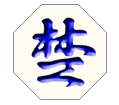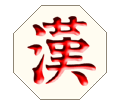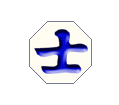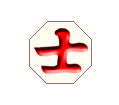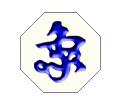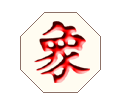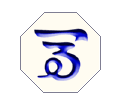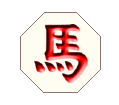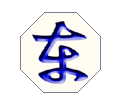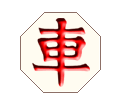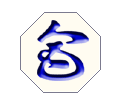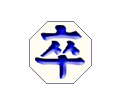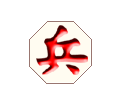Janggi figures
Currently Janggi figures are in the shape of octagonal made from plastic, but You can also find Janggi sets with wooden figures. Distinguishing the Janggi figures is a tricky at the beggining (for European) because all of them are in the same shape, and all of them are marked with “hashes” :). One player has a red markings – another green or blue.
Every player starts the game having five soldiers, two elephants, two horses, two chariots, two cannons, two advisors and one general. Of course (what is familiar to many strategic games) it’s possible to have handicup (stronger player is starting without a piece to equalize the advantage from heigher skills).
General (King)
It’s said that general is the equivalent of chess King. He’s called also “jaggun”. You can find different description for general – from the chinesse nomenclature the red one is Han and the green/blue is Chu/Cho (it’s from the fight between chinesse dynasties). In the South Korea the red one is Jang (general) and the green one is Gwan (minister). General is easy to recognize due to the size – it’s the biggest figure in Janggi. He starts the game in the palace (in korean “goong”) – or in the middle point, or in the middle of lower edge. General can move one step each side, but only in the palace. Of course when You loose general You loose the game. If generals are staying just vis a vis and none of the player can make a legal move then it’s draw – bikjang>.
Guardians (3pkt)
Guardians are often called asistents or advisor (the mark on the figure is sa). They are set at left and right side of the general. This is the closest guard for the general, so as he they cannot move outside the palace. Due to the function and limitation for moves only in the palace, guardians are strictly defensive figures.
Elephants (3pkt)
The sign used to mark elephants is sang. Elephant movement is similar to chess knight – the difference is that he has a little bigger range (1 step vertically/horizontally and 2 by diagonal). Additional difference is that in Janggi elephant cannot jump over other figures – so if anything is on the way, he cannot move. There’s some variants of setting elephants on the board. The main rule is that he has to be set outside the advisor, but he can be put just near to the advisor or one point further (see start positions)).
Horses (5pkt)
Figure marked as a ma is very similar to chess knight – one field horizontally/vertically and one through diagonal (as a “L” letter). The difference is that Janggi horse cannot jump over other figures (so he has to have clear way to move).
Charriots (13pkt)
Charriots marked as a cha are set in the corner (as rooks in chess). They are moving vertically or horizontally (as the chess rook), but when they are in palace they can also move through diagonal. Charriot cannot jump over other figures.
Cannons (7pkt)
Cannon (marked as po) is a figure which jumps over other figures (vertically or horizontally). Cannons cannot bit each other and they cannot jump over other cannon. Cannons at the beggining of the game are set one line behind the pawns (see start positions).
Soldiers (2pkt)
Red soldier is marked with a symbol byeong and the green with the symbol jol. Each army has 5 soldiers at the beggining of the game. They are set in a row in front of the army. In the korean chess there’s no promotion of the soldier to strongest figure when he reaches 10th horizontal line. In some regional variants of Janggi it’s allowed to promote a soldier to previously lost figure, but it’s not a tournament rule.
Previous (Janggi rules) << >> Next (Janggi board and start positions)
